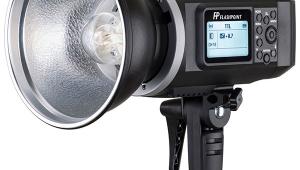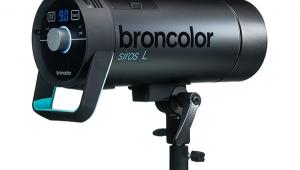Visatec’s LOGOS 1600 RFS; On Location Or In The Studio
When I was operating a commercial studio in Hollywood, California, my prized possession was a Swiss-made Broncolor 2400 ws power pack and three lamp heads; it was the setup I relied upon for most of my product photography. What made the Bron lights special was a patented gold coating over the U-shaped flash tube. The purpose was to absorb the UV light that is produced by all electronic flash. UV light has a subtle effect on color. It can lower the overall contrast and saturation and cause images to appear slightly cool—often apparent in the shadows. The coating worked so well that I could see a visible difference between images made with my other strobes and the Bron (in the 1980s UV coating on flash tubes was not as common as it is today). According to Goran Kukic of Bron, since 2006 the company has been using a new coating that is even better and more stable. I believe this to be true based on the images I was able to make with a set of Visatec LOGOS 1600 RFS monolights.
The LOGOS 1600 RFS monolights I tested are made by Bron to compete with other high-end units. The monolights are available individually or in kits. For this review Visatec sent me a 216 RFS Kit which includes two monolights, a standard reflector, a set of barn doors, a white umbrella, an umbrella reflector, a 15-foot sync cable, a RFS (Radio Frequency System) transmitter (for wireless remote triggering), a travel bag, and power cables (#1). The same kit is available without the RFS. However, I have been using wireless remote triggering for years and swear by it. Though it may not seem like much, the ability to work untethered to your strobe lights is a blessing, especially on location, but also in the studio. This is even more so now that we find ourselves tethered to a computer. In my studio I am using a Nikon D700 tethered to an iMac with Nikon’s Camera Control Pro 2 software (#2).
 |
 |
|
|
1
|
2
|
|
|
||
Features
As with most monolights, all of the controls for the LOGOS are accessible on the panel. The output of the light is digitally variable in 1⁄10-stop increments over a four-stop range, from a setting of 6.0 to 10.0. To the right of the energy control display are the up/down buttons used for all of the controls (#3). Repeatedly pressing either the up or down button changes the energy output by 1⁄10 stop, while holding it down causes the power to jump by one full stop. So, by holding the up button down, the power would jump from the displayed 7.3 to 8.3, then 9.3, and then 10.0.
 |
|
|
3
|
|
|
The LOGOS 1600 RFS uses a 150w halogen modeling lamp which can be used proportionally to the flash output or switched to full power by holding down the modeling light (mod) key for 1 second. Part of the design of the LOGOS, found on other Bron lights as well, is that the modeling lamp fits beneath the U-shaped flash tube and combined with proportional output provides an accurate preview.
Each monolight is equipped with a photocell which allows it to be triggered by a handheld flash unit. If you are using the RFS model this is not important as the transmitter will trigger all of the heads simultaneously. Of course, it is still a good thing to have in the event that your transmitter is lost, stolen, or stepped on. When necessary the photocell can be turned off by pressing the cell button on the back panel.
There are two sync cable sockets on the back of the LOGOS. The sync/com socket can be used for a computer link. The sync socket is for a standard sync cable, such as the one that comes with the LOGOS kit. When using a sync cable, as opposed to a RFS, it is important that the triggering voltage of any strobe light be 6v or less in order to protect the camera’s X-sync terminal. Although not specified, the LOGOS is said to have a very low voltage that is safe for all makes and models of cameras.
Across the top of the back panel there are six programmable functions. These are accessed in order, from left to right, by repeatedly pushing the aux button and then pressing the up and down arrow keys (next to the energy control). The first setting, prop, allows custom setting of the modeling light output to match a variety of situations. For example, if the flash power is set at 10.0, the modeling light output would always be on full power. To conserve energy and extend the life of the modeling lamp you could switch it to P1 or LO. There are other custom settings from up to P5 and HI.
The second setting, seq, is used to set up to 50 multiple flash discharges for photographing moving objects. The third setting, dim, is a charging dimmer and boost function. Using dim causes the modeling light to switch off while the unit is charging. It also allows the modeling lights to fade out during flash sequences. The fourth setting, buz, turns the ready buzzer signal on. When the unit is at full charge the buzzer will let you know. This helps to prevent missing photos by releasing the shutter before the monolights are fully charged. The fifth setting, slow, is used in case of a weak power supply. When enabled, charging time is extended to approximately double the standard time. The sixth setting, unit, is for wireless triggering capabilities. A camera or computer can be assigned a unique address for wireless triggering.
Other important features to consider are fan cooling, thermal protection, and a metal housing with an integrated umbrella holder. The full line of Visatec light-modifying accessories can be used with the unique Visatec interlocking bayonet. The bayonet allows light-shaping tools to be rotated 360? for further control.
That about wraps up the important features. What is missing from this unit is the ability to automatically dump an accumulated charge stored in the capacitors when the power is reduced via the energy control. This is almost a standard feature on modern microprocessor-driven monolights and I am surprised not to find it on this high-end competitor. The other weak link is the limited four-stop range. Most high-end monolights have at least a five-, and often six-, stop range of variable flash output.

















































